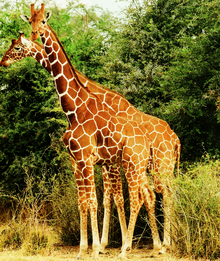This article needs additional citations for verification. (March 2024) |
| Reticulated giraffe Temporal range: Pleistocene - Recent[1]
| |
|---|---|

| |
| Scientific classification | |
| Domain: | Eukaryota |
| Kingdom: | Animalia |
| Phylum: | Chordata |
| Class: | Mammalia |
| Order: | Artiodactyla |
| Family: | Giraffidae |
| Genus: | Giraffa |
| Species: | G. reticulata
|
| Binomial name | |
| Giraffa reticulata (De Winton, 1899)
| |

| |
| Range in dark green | |
| Synonyms | |
|
Giraffa camelopardalis reticulata | |
The reticulated giraffe (Giraffa reticulata[3] or Giraffa camelopardalis reticulata[4]) is a species/subspecies of giraffe native to the Horn of Africa. It is differentiated from other types of giraffe by its coat, which consists of large, polygonal (or squared), block-like spots, which extend onto the lower legs, tail and face. These prominent liver-red spots also show much less white between them, when compared to other giraffe species.[5] With up to 6 meters in height, the reticulated giraffe is the largest subspecies of giraffe and the tallest land animal in general.[4][6] While the reticulated giraffe may yet still be found in parts of its historic range, such as areas of Somalia and Ethiopia, its population stronghold is primarily within Kenya.[7][8] There are approximately 8,500 individuals living in the wild.[7] In both captivity and the wild, as of 2024 there are 15,785 individuals across the world.[citation needed]
Reticulated giraffes can interbreed with other giraffe species in captivity, or if they come into contact with other species of giraffe in the wild, such as the Masai giraffe (G. camelopardalis tippelskirchii).
Along with the aforementioned Masai giraffe, as well as the Baringo or Rothschild's giraffe (G. c. rothschildi), the reticulated giraffe is among the most commonly seen giraffe species in animal parks and zoos.[9]
- ^ "Fossilworks: Giraffa camelopardalis".
- ^ Cite error: The named reference
iucnwas invoked but never defined (see the help page). - ^ Groves, Colin; Grubb, Peter (2011). Ungulate Taxonomy. JHU Press. pp. 68–70. ISBN 9781421400938.
- ^ a b "Netzgiraffe - Tierpark Hellabrunn". www.hellabrunn.de. Retrieved 2024-07-29.
- ^ "Giraffe | National Geographic". 2011-03-10. Archived from the original on October 12, 2016. Retrieved 2018-03-20.
- ^ "Tierart (Detailansicht)". www.wilhelma.de (in German). Retrieved 2024-07-29.
- ^ a b "Rare white giraffes spotted in Kenya conservation area". Naaman Zhou, The Guardian, 14 September 2017. Accessed 14 September 2017.
- ^ Cite error: The named reference
:0was invoked but never defined (see the help page). - ^ ISIS (2010). Giraffa. Version 1 October 2010
